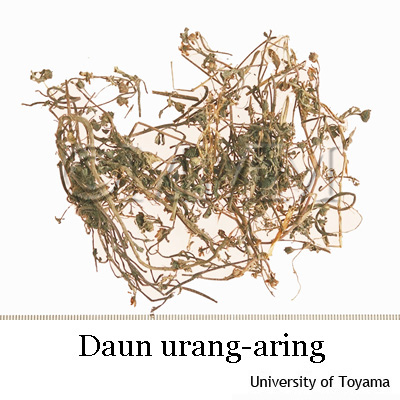Crude drug sample data base
※Click on the image to enlarge it.
Scientific information data base
| Crude drug name | Indonesian name, English name | Daun urang-aring | ||
|---|---|---|---|---|
| crude drug image |
| |||
| Original plant name | Eclipta alba Hassk. | |||
| Family name | Compositae | |||
| Used part | Leaves | |||
| Distribution area | It occurs worldwide in the tropics and subtropics. It occurs elsewhere in Java from lowland to 1500m altitude. It grows as a weed in rice fields, sugar and coconut plantations, scattered in grassy plains [222]. | |||
| Description | Leaves opposite, simple, oblong-lanceolate, 2-7 cm x 1-2 cm, base attenuate, apex pointed, margins entire or slightly toothed. The plant is a straggling annual or rather short-lived perennial herb, stem cylindrical, rooting at the lower node, reddish, with tap root. Inflorescence axillary or terminal head, solitary or up to 3 together, flowers white. Fruit an oblong achene, triangular or compressed with 1 central rib on each side, black [220]. | |||
| Drug effect | Sweet, sour, cooling [231]. | |||
| Specific actions | Hemostatic, antipyretic [231]. | |||
| Frequency in use | Moderate | |||
| Common uses | Leaves are crushed in water to obtain juice which is commonly used to cool the head, rinse hair to stimulate hair growth and to keep the hair black. A mixture with coconut oil is used to stimulate hair growth. It is also rubbed all over the scalp of a newborn baby to stimulate hair growth. Cooked leaves are eaten [201]. | |||
| Pharmacological effect | The active constituent wedelolactone is a potent and selective 5-lipoxygenase-inhibitor through an oxygen radical scavenger mechanism [220]. Fraction of alcoholic extract of fresh leaves of Eclipta alba contains coumestan wedelolactone and desmethylwedelolactone as major components and exhibited maximum hepatoprotective activity [PMID:11883149]. Aqueous and hydroalcoholic extracts of Eclipta alba showed a potential neuropharmacological activity as a nootropic and having the property of attenuating stress induced alterations [PMID:16054316]. Leaf suspension of E. alba could reduce blood glucose level, which shows that it possesses an anti hyperglycemic activity [PMID:15369623]. | |||
| Medical system | Indonesian medicine (Jamu) | |||
| Traditional usage | The leaves are used to treat difficulty in breathing, headache, boils, toothache, menstrual disorder [201]. Juice of the leaves is rubbed on the chest to treat breathing difficulties. Crushed leaves is mixed with a small amount of salt and rubbed on the scalp to treat headache [201]. | |||
| Formulation | 1) Hair loss: 10 grams of leaves is pounded and add 1/2 cup of water, squeezed and strained. Apply the juice on the scalp with light massage [207]. A mixture of crushed leaves with coconut oil is used as a hair oil [201]. 2) Haemorrhoids/hemorrhoids: 7 aboveground parts of E. alba, 7 roots of Euphorbia prostata, 7 pieces of leaves of Coleus scutellaroides, 1 piece of Helicteres isora, are boiled with 110 ml of water. Drink 100 ml of the decoction once a day for 14 days [231]. | |||
| References | Reference book Tips! | [201] K. Heyne, Tumbuhan Berguna Indonesia, Vols. 1-4, 1987. Diedarkan Oleh Koperasi Karyawan Departemen Kehutanan, Jakarta, Indonesia. Vol. 3, p 1833. [207] Badan Penelitian Dan Pengembangan Kesehatan and Departemen Kesehatan, Kesejahteraan Sosial Ri. Vols. 1-5, Inventaris Tanaman Obat Indonesia, Jakarta, Indonesia. Vol. 1, Part 1 (2000), pp 99-100. [220] van Valkenburg, J.L.C.H. and Bunyapraphatsara, N. (editors). Plant Resources of South-East Asia No. 12 (2). Medicinal and posionous plants 2. Prosea Foundation, Bogor, Indonesia, 2002. pp 237-240. [222] P.T. Eisai Indonesia: Medical Herb Index in Indonesia (Second edition).1995. p 222. [228] Christophe, Wiart.: Medicinal Plants of Southeast Asia. Prentice Hall. Malaysia. 2002. pp 311-312. [231] Soedibyo, Mooryati: Alam Sumber Kesehatan: Manfaat dan Kegunaan (Natural resources for health. Benefits and uses). Balai Pustaka. 1998. pp 380-381. | ||
| Research paper | 1. Thakur VD, Mengi SA. Neuropharmacological profile of Eclipta alba (Linn.) Hassk. J Ethnopharmacol. 31;102(1):23-31., 2005. (PMID: 16054316) 2. Ananthi J, Prakasam A, Pugalendi KV. Antihyperglycemic activity of Eclipta alba leaf on alloxan-induced diabetic rats. Yale J Biol Med. 76(3):97-102, 2003. (PMID: 15369623) 3. Singh B, Saxena AK, Chandan BK, Agarwal SG, Anand KK. In vivo hepatoprotective activity of active fraction from ethanolic extract of Eclipta alba leaves. Indian J Physiol Pharmacol. 45(4):435-41, 2001. (PMID: 11883149) | |||
| Remarks | The 5-lipoxygenase inhibition, hepatoprotective, antimyotoxic, anti-haemorrhoagic/anti-hemorrhoagic effects of the extracts and its constituents need further researches [220]. | |||
| Last renewal date | 2024/03/05 | |||


